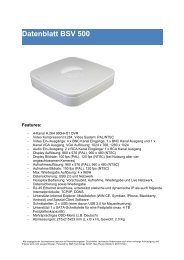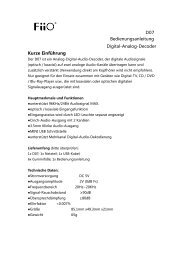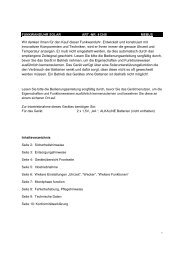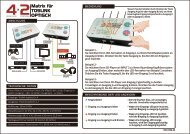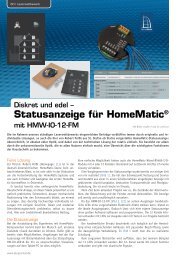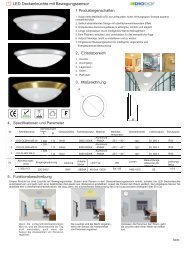Wir wün- schen Ihnen viel Spaß beim Eierkochen! PiepEi und ... - ELV
Wir wün- schen Ihnen viel Spaß beim Eierkochen! PiepEi und ... - ELV
Wir wün- schen Ihnen viel Spaß beim Eierkochen! PiepEi und ... - ELV
Sie wollen auch ein ePaper? Erhöhen Sie die Reichweite Ihrer Titel.
YUMPU macht aus Druck-PDFs automatisch weboptimierte ePaper, die Google liebt.
Diesen Abschnitt vom Händler abstempeln<br />
lassen <strong>und</strong> zusammen mit dem<br />
Kassenbeleg aufbewahren – gilt als<br />
Garantieschein.<br />
Faites tamponner ce talon par le vendeur<br />
du magasin et conservez-le avec le ticket<br />
de caisse. C’est votre bon de garantie.<br />
Let your dealer stamp this couponkeep<br />
together with your receiptapplies<br />
as warrant coupon.<br />
Hagan sellar este talón por el vendedor<br />
y consérvelo con el ticket de<br />
caja. Es su bono de garantía.<br />
Stempel/Kaufdatum: | stamp/date of purchase | Cachet/Date de l’achat<br />
callapo/data:<br />
Brainstream GmbH<br />
33813 Oerlinghausen<br />
Germany<br />
Phone: +49 5202 97070<br />
www.brainstream.de<br />
info@brainstream.de<br />
<strong>Wir</strong> <strong>wün</strong>- <strong>schen</strong> <strong>Ihnen</strong> <strong>viel</strong> <strong>Spaß</strong> <strong>beim</strong><br />
<strong>Eierkochen</strong>! <strong>PiepEi</strong> <strong>und</strong> Eier<br />
zusam- men lagern – spart auch das Suchen<br />
nach der Eieruhr.<br />
<strong>PiepEi</strong>– die [k]ultimative Eieruhr zum Mitkochen<br />
EggBeep! – the [c]ultimate eggtimer to cook eggs!<br />
Bip œuf qui fait bip-bip quand les œufs sont cuits ...<br />
El huevo (en)cantador que hace bip-bip cuando los huevos están cocidos…
Inhalt | Index | Objet<br />
<strong>Wir</strong> <strong>wün</strong><strong>schen</strong> <strong>Ihnen</strong> <strong>viel</strong> <strong>Spaß</strong><br />
Anleitung deutsch Seite 3–6<br />
<strong>beim</strong> <strong>Eierkochen</strong>! <strong>PiepEi</strong> <strong>und</strong> Eier<br />
Instruction english page 7–10 zusammen lagern – spart auch das<br />
Suchen nach der Eieruhr.<br />
Instruction français page 11–14<br />
Instrucciones español página 15–21<br />
Batterie | Battery | Piles | Pila eléctrica<br />
Seite | page 22<br />
Hart, weich – oder was?<br />
Das gelbe <strong>PiepEi</strong> „Detlef“ kontrolliert die Weicheier für Genießer, die das<br />
Eiweiß wachsweich <strong>und</strong> das Eigelb noch flüssig bevorzugen.<br />
Das orange <strong>PiepEi</strong> „Schantall“, nichts Halbes <strong>und</strong> nichts Ganzes, sorgt dafür,<br />
dass das Eiweiß fest <strong>und</strong> das Eigelb im Kern noch flüssig ist.<br />
Das blaue <strong>PiepEi</strong> „Hartmut“ kümmert sich um die hartgesottenen Gourmets.<br />
Eigelb <strong>und</strong> Eiweiß sind fest.<br />
3<br />
<strong>Spaß</strong> <strong>beim</strong><br />
<strong>Eierkochen</strong>!<br />
<strong>PiepEi</strong> un
Eier kochen mit <strong>PiepEi</strong><br />
Lagern Sie <strong>PiepEi</strong> mit Ihren Hühnereiern zusammen!<br />
Denn <strong>PiepEi</strong> basiert auf einem thermi<strong>schen</strong> Modell,<br />
welches nur dann ganz genau ist, wenn <strong>PiepEi</strong> <strong>und</strong><br />
das zu kochende Ei die gleiche Temperatur haben.<br />
<strong>PiepEi</strong> misst die Wassertemperatur <strong>und</strong> berechnet die<br />
Innentemperatur des „echten“ Eis.<br />
Sie können <strong>PiepEi</strong> mit den Hühnereiern zusammen in<br />
kaltes oder auch kochendes Wasser legen. Bei Start<br />
mit kaltem Wasser können Sie sich das Anpieksen<br />
sparen.<br />
Was bedeuten die Pieps?<br />
1. Piep: Der erste Piep kommt bei ca. 45°C<br />
Wassertemperatur <strong>und</strong> bedeutet „Ei am Okay“<br />
(<strong>PiepEi</strong> funktioniert)<br />
2. Piep: Wenn das Wasser kocht, macht <strong>PiepEi</strong><br />
zum zweiten Mal piep, das Zeichen, dass die Energiezufuhr<br />
reduziert werden kann.<br />
3. Melodie: Haben die Hühnereier den ge<strong>wün</strong>schten<br />
Härtegrad erreicht, erklingt die Melodie<br />
„Ich wollt’ ich wär’ ein Huhn...“ Eier <strong>und</strong> <strong>PiepEi</strong> mit<br />
kaltem Wasser abschrecken <strong>und</strong> genießen.<br />
Nach der regulären Kochzeit spielt<br />
<strong>PiepEi</strong> die Melodie 3 Minuten. Jede<br />
Minute danach ertönt ein zusätzlicher<br />
Piepton. So kann man individuelle<br />
Geschmacksunterschiede ausgleichen.<br />
nach 1 Minute piep+Melodie,<br />
nach 2 Minuten piep+piep+Melodie,<br />
nach 3 Minuten piep+piep+piep+Melodie.<br />
(Mit <strong>PiepEi</strong> Detlef ist man am flexibelsten<br />
– von weich bis mittel)<br />
5
Die Größe der Eier?<br />
<strong>PiepEi</strong> ist auf mittlere <strong>und</strong> große Eier optimiert. Bei extragroßen Eiern warten sie bitte ca.<br />
30 Sek<strong>und</strong>en, bevor Sie das Ei aus dem Wasser nehmen.<br />
<strong>PiepEi</strong> funktioniert auch im Hochgebirge, wo das Wasser schon unter 100°C kocht. Einer der<br />
Vorteile von <strong>PiepEi</strong> ist es, dass es nach einem Temperaturmodell funktioniert, also auch wenn<br />
das Wasser nicht richtig kocht oder bei Temperaturen unter oder über 100°C kocht. Übrigens<br />
kann man natürlich mehrere Eier im Topf mit dem <strong>PiepEi</strong> kochen.<br />
Richtige <strong>PiepEi</strong>-Behandlung<br />
Das <strong>PiepEi</strong> bitte nie in die Mikrowelle geben, es wäre sein Tod. Auch ein Topf ohne Wasser<br />
ist sehr unges<strong>und</strong> für das <strong>PiepEi</strong>. Verformte <strong>PiepEi</strong>er bitte nicht mehr benutzen.<br />
<strong>Wir</strong> <strong>wün</strong><strong>schen</strong> <strong>Ihnen</strong> <strong>viel</strong> <strong>Spaß</strong> <strong>beim</strong> <strong>Eierkochen</strong>!<br />
Hard, soft – or ..?<br />
1.<br />
45°C<br />
Piep<br />
Wassertemperatur<br />
Der erste Piep kommt<br />
<strong>und</strong> bedeutet<br />
bei ca.<br />
yolk runny.<br />
„Ei am Okay“ (<strong>PiepEi</strong><br />
funktioniert)<br />
kocht, macht<br />
2.<br />
<strong>PiepEi</strong><br />
Piep Wenn<br />
zum<br />
das<br />
zweiten<br />
Wasser<br />
Mal piep, das Zeichen, d<br />
The yellow Egg-Beep! Softy is controlling the soft boiled<br />
eggs for bon vivants who like the white soft and the egg<br />
The orange Egg-Beep! Medium for those who are still<br />
<strong>und</strong>etermined, tending to the medium boiled eggs. The<br />
white is hard and the egg yolk soft inside.<br />
The blue Egg-Beep! Hardy is for all the hard boiled<br />
gourmets. The egg white is hard and the yolk too.<br />
7
Boiling eggs with Egg-Beep!<br />
You have to store Egg-Beep! together with the real eggs. EggBeep! is based on an thermal<br />
model and can only calculate the exact time the egg yolk is set if Egg-Beep! and the real<br />
eggs have the same temperatur. Egg-Beep! measures the water temperatur and calculates the<br />
inner temperatur of the real egg.<br />
Put Egg-Beep! and the real eggs together in cold or boiling water.<br />
What do the beeps mean?<br />
1. Beep: The first beep reso<strong>und</strong>s when the<br />
water temperatur is 45°C and means,<br />
“I am ok!” (Egg-Beep! works)<br />
2. Beep: When the water is boiling, Egg- Beep!<br />
makes its 2nd beep. You may lower the heat and<br />
reduce the energy addition.<br />
Melody: The eggs have reached right hardness<br />
grade. You can hear the first so<strong>und</strong>s of a song.<br />
Remove Egg-Beep! and real eggs from the water<br />
and soak them both in cold water and enjoy.<br />
After the regular cooking time each Egg-<br />
Beep! will beep for 3 minutes. Individual<br />
tastes can be regulated.<br />
after 1st minute beep + melody,<br />
after 2nd minute beep + beep + melody<br />
after 3rd minute beep + beep + beep + melody<br />
(With Egg-Beep! Softy you can also cook<br />
medium boiled eggs.)<br />
9
Tips for Eggsperts …<br />
Egg-Beep! is optimised for medium and large eggs. If you choose XL-Eggs you have to<br />
extend the cooking time for ~ 30seconds. To hear Egg-Beep! clearly leave the cover off the<br />
pot. You can also cook as many eggs as you like in one pot with Egg-Beep!<br />
The right Egg-Beep! treatment<br />
Never use Egg-Beep! in a microwave!<br />
Never use Egg- Beep! in a pot without water!<br />
Do not try to open Egg-Beep!<br />
Do not use a damaged or deformed Egg-Beep!<br />
Do not discard Egg-Beep! in an open fire!<br />
Do not swallow Egg-Beep!<br />
Only use Egg-Beep! to boil eggs!<br />
A la coque, mollets ou durs, à vous de choisir? 11<br />
Bip œuf jaune, c’est M. Lemou. Il veille à ce que vos œufs<br />
soient cuits à la coque dans les règles de l’art : le blanc<br />
est bien moelleux et le jaune est encore liquide.<br />
Wassertemperatur<br />
1. Piep Der erste<br />
<strong>und</strong> bedeutet<br />
Piep kommt<br />
„Ei am<br />
bei<br />
Okay“<br />
ca. 45°C<br />
(<strong>PiepEi</strong><br />
Bip œuf orange, c’est Mlle Mollet. Elle n’arrive pas à se<br />
funktioniert) décider alors <strong>PiepEi</strong> zum<br />
2. avec zweiten<br />
Piep elle le blanc Wenn de l’oeuf Mal<br />
das est piep,<br />
Wasser bien pris das<br />
kocht, tan- Zeichen,<br />
macht<br />
d<br />
dis que le jaune reste crémeux au milieu.<br />
ass die Energiezufuhr reduziert werden kann.<br />
Bip œuf bleu, c’est M. Ledur… pour les durs à cuire. Le<br />
jaune et le blanc sont bien fermes tous les deux.
Bip œuf, mode d’emploi…<br />
Conservez Bip œuf et les autres œufs de poule ensemble<br />
au même endroit ! Car Bip œuf possède un mécanisme<br />
thermique qui ne fonctionne avec exactitude que<br />
si Bip œuf et l’œuf à cuire sont à la même température.<br />
Bip œuf mesure la température de l’eau et calcule<br />
la température intérieure du « vrai » œuf.<br />
Vous pouvez mettre Bip œuf et les œufs de poule dans<br />
l’eau froide ou bien dans l’eau bouillante. Si vous les<br />
mettez dans l’eau froide, vous n’avez pas besoin de<br />
perforer les « vrais » œufs auparavant.<br />
Que signifient les bips<br />
1er bip: Le premier bip retentit quand l’eau atteint<br />
une température d’environ 45° C et il signifie: « Moi,<br />
Bip œuf, je suis enchanté» (Bip œuf fonctionne).<br />
2ème bip: Lorsque l’eau commence à bouillir, Bip<br />
œuf émet un deuxième bip, signe que vous pouvez<br />
réduire la température.<br />
3ème bip: une petite mélodie. Lorsque les œufs<br />
de poule ont atteint la consistance désirée, vous<br />
entendez une petite mélodie. Il est temps de passer<br />
les œufs et Bip œuf sous l’eau froide et de vous<br />
régaler…<br />
13<br />
Après le temps de cuisson normal,<br />
Bip œuf émet la mélodie pendant 3<br />
minutes. A la fin de chaque minute,<br />
vous entendez un nouveau bip, ce<br />
qui permet de tenir compte de chacun<br />
des différents goûts.<br />
Après une minute: bip+mélodie;<br />
Après deux minutes: bip+bip+mélodie<br />
Après trois minutes:bip+bip+bip+<br />
mélodie<br />
(C’est Bip œuf M. Lemou qui est le plus<br />
pratique : la consistance de vos œufs va de<br />
mou à mollet)
Et le calibre des œufs ?<br />
Bip œuf fonctionne le mieux avec les œufs de calibre moyen et gros. Dans le cas d’œufs de<br />
très gros calibre, attendez environ 30 secondes avant de retirer l’œuf de l’eau.<br />
Comment bien se servir de Bip œuf?<br />
Ne mettez jamais Bip œuf dans le micro-ondes, ce serait sa mort<br />
certaine. Il supporterait aussi très mal une casserole sans eau.<br />
N’utilisez plus les Bip œufs déformés.<br />
Ranger Bip œuf avec les autres « vrais » œufs vous évitera de le<br />
chercher inutilement.<br />
Nous vous souhaitons beaucoup de plaisir à cuire vos œufs !<br />
¿Pasados por agua (3 minutos), pasados por<br />
agua (6 minutos) o huevos duros? Usted elige.<br />
El huevo cantante amarillo es el Sr. Blando. Éste controla que los<br />
huevos estén pasados por agua dentro de las reglas del arte, en<br />
solo tres minutos: la clara bien blanda y la yema todavía liquida.<br />
Wassertemperatur<br />
1. Piep Der erste<br />
<strong>und</strong> bedeutet<br />
Piep kommt<br />
„Ei am<br />
bei<br />
Okay“<br />
ca. 45°C<br />
(<strong>PiepEi</strong><br />
El huevo cantante naranja es la Srta. Blanda. No se llega a decidir<br />
funktioniert) y con ella la clara del <strong>PiepEi</strong> zum<br />
2. huevo zweiten<br />
Piep queda Wenn dura mientras Mal<br />
das<br />
piep,<br />
Wasser que la yema das<br />
kocht,<br />
Zeichen,<br />
macht<br />
d<br />
queda blanda en el centro. ass die Energiezufuhr reduziert werden kann.<br />
El huevo cantante azul es el Sr. Duro…Para los duros de cocer.<br />
Tanto la clara como la yema quedarán duras.<br />
15
El huevo cantante,<br />
modo de empleo…<br />
¡Conservar el huevo cantante y los otros huevos de<br />
gallina en el mismo sitio! El huevo cantante posee un<br />
mecanismo térmico que solo funciona con exactitud si<br />
el huevo cantante y el huevo a cocer están a la misma<br />
temperatura. El huevo cantante mide la temperatura<br />
del agua y calcula la temperatura interior del “verdadero”<br />
huevo.<br />
Wassertemperatur<br />
1. Piep Der erste<br />
<strong>und</strong><br />
Piep<br />
bedeutet<br />
kommt<br />
„Ei<br />
bei<br />
am<br />
ca.<br />
Okay“<br />
45°C<br />
(<strong>PiepEi</strong><br />
funktioniert)<br />
macht <strong>PiepEi</strong><br />
2. Piep<br />
zum zweiten<br />
Wenn das<br />
Mal<br />
Wasser<br />
piep,<br />
kocht,<br />
Zeichen, d<br />
das<br />
17<br />
Puede poner el huevo cantante y<br />
los huevos de gallina en el agua fría<br />
o bien en el agua cociendo. Si los<br />
pone en el agua fría, no tendrá que<br />
perforar los “verdaderos” huevos<br />
antes.<br />
1.<br />
45°C<br />
Piep<br />
Wassertemperatur<br />
Der erste Piep kommt<br />
<strong>und</strong> bedeutet<br />
bei ca.<br />
„Ei am Okay“ (<strong>PiepEi</strong><br />
funktioniert)<br />
kocht, macht<br />
2.<br />
<strong>PiepEi</strong><br />
Piep Wenn<br />
zum<br />
das<br />
zweiten<br />
Wasser<br />
Mal piep, das Zeichen, d
¿Que significan los bips?<br />
1r Bip El primer bip suena cuando el agua adquiere una temperatura de aproximadamente<br />
45ºC y significa: “Yo, el huevo cantante estoy encantado” (el huevo cantante funciona).<br />
2º Bip Cuando el agua empieza a cocer, el huevo cantante emite un seg<strong>und</strong>o bip, signo de<br />
que puede reducir la temperatura.<br />
3r Bip: una pequeña melodía.Cuando los huevos de gallina han adquirido la consistencia<br />
deseada oirá una pequeña melodía. Es el momento de pasar los huevos y el huevo cantante<br />
bajo el agua fría y disfrutar …<br />
Después del tiempo de cocción normal el huevo cantante<br />
emite la melodía durante tres minutos. Al final de<br />
cada minuto oirá un nuevo bip, lo que le permitirá tener<br />
en cuenta cada uno de los diferentes sabores.<br />
Después de un minuto: Bip+melodía<br />
Después de dos minutos:Bip+Bip+Melodía<br />
Después de tres minutos: Bip+Bip+Bip+Melodía<br />
(El huevo cantante Sr. Blando es el más practico: la<br />
consistencia de vuestros huevos va de blando a duro).<br />
19
¿Y el tamaño de los huevos?<br />
El huevo cantante funciona mejor con huevos de tamaño medio o grande.<br />
En el caso de los huevos muy grandes, espere aproximadamente<br />
30 seg<strong>und</strong>os antes de retirar el huevo del agua.<br />
El huevo cantante funciona también en alta montaña, allí donde el agua<br />
empieza a cocer por debajo de 100ºC. Una de las ventajas del huevo<br />
cantante, es que funciona a partir de un nivel de temperatura, es decir<br />
cuando el agua no ha llegado totalmente a hervir o cuando hierve a temperaturas<br />
por encima o por debajo de 100ºC. Puede, por supuesto, hervir<br />
varios huevos a la vez en la misma cacerola con el huevo cantante.<br />
¿Cómo utilizar el huevo cantante?<br />
No ponga nunca el huevo cantante en el microondas, sería su muerte<br />
segura. Soportaría también muy mal una cacerola sin agua. No utilice los<br />
huevos cantantes si están deformados.<br />
Guardar el huevo cantante con los otros “verdaderos” huevos le evitará<br />
buscarlo inútilmente.<br />
¡Le deseamos mucho placer al cocer sus huevos!<br />
21
Wie lange hält die Batterie? How long does<br />
the battery last?<br />
Das <strong>PiepEi</strong> hat eine begrenzte Lebensdauer<br />
von etwa 1½ Jahren.Wie merkt man, daß die<br />
Batterie leer wird? <strong>PiepEi</strong> macht einen kurzen<br />
Piepton, sobald das Wasser wärmer als ca.<br />
45°C ist. Dies ist ein Zeichen, dass die Batterie<br />
ok ist. Wenn dieser Ton nicht mehr zu<br />
hören ist, entsorgen Sie das <strong>PiepEi</strong> bitte über<br />
das Batterie-Rücknahmesystem.<br />
<strong>PiepEi</strong> ist auf Lebensmitteltauglichkeit<br />
geprüft.<br />
The battery has a limited economic life-time. It<br />
will last approximately 1 ½ years. Egg-Beep!<br />
makes it first beep after the water temperature<br />
has reached ~ 45°C – Egg-Beep! is ok!<br />
If this so<strong>und</strong> is not hearable anymore you have<br />
to dispose Egg-Beep! like a battery.<br />
Egg-Beep! has been tested and fo<strong>und</strong> to<br />
be safe according to food laws.<br />
Quelle est la durée de<br />
vie des piles?<br />
Bip œuf a une longévité limitée à environ<br />
1 année et demie, ce qui correspond à la<br />
durée de vie des piles. A quoi remarque-t-on<br />
que les piles sont vides? Que faut-il alors faire<br />
? Bip œuf émet un bref bip dès que la température<br />
de l’eau dépasse les 45°C, ce qui signifie<br />
que les piles sont encore en état de marche.<br />
Lorsque vous n’entendez plus ce son,<br />
Bip œuf a rendu l’âme. Veuillez le jeter dans la<br />
poubelle destinée aux piles usagées.<br />
Bip œuf a fait l’objet de tests et il peut<br />
être utilisé sans problème avec des aliments.<br />
23<br />
¿Cuál es la duración de<br />
las pilas?<br />
El huevo cantante tiene una longevidad limitada<br />
a aproximadamente un año y medio,<br />
correspondiente a la duración de las pilas.<br />
¿Cómo sabemos que las pilas están vacías?<br />
¿Qué hay que hacer entonces? El huevo cantante<br />
emite un breve Bip cuando la temperatura<br />
del agua supera los 45ºC, lo que significa<br />
que las pilas todavía funcionan. Cuando no<br />
oiga este ruido, el huevo cantante habrá<br />
entregado su alma. Sean tan amables de<br />
tirarlo a la papelera destinada al reciclaje de<br />
pilas usadas.<br />
El huevo cantante ha sido probado y<br />
puede ser utilizado sin ningún problema<br />
con alimentos.



